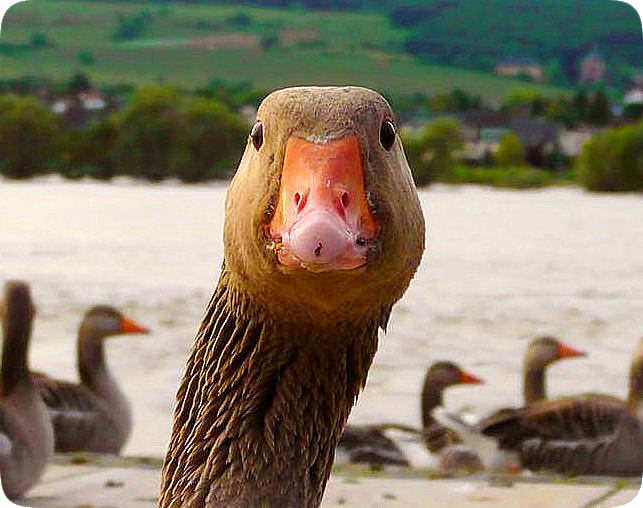We are off to the snail races . . . it is likely to be an all-day event . . .
Roger: Why did the snail cross the road?
Edgar: I don’t know; he hasn’t gotten to the other side yet.
Snails can take 33 hours to crawl a single mile. However, if you consider the size of snails compared to the distance, they actually make pretty good time. And what’s more, they do it without any legs!
Midge: When does a snail go as fast as a train?
Marge: When it’s on the train.
The fastest-moving land snail, the common garden snail, has a speed of about 0.050372 kilometers (0.0313 miles) per hour. This breathtaking pace must be the reason so many pet snails are named Speedy.
Snails Facts
- A group of snails is called a hood, an escargatoire, a rout, or a walk.
- The average snail moves at a rate of approximately 0.000362005 miles per hour.
- Snails living in the wild, which includes in gardens and on farms, can live for two to five years.
- Snails living in captivity, or being held and cared for by humans, can live for as long as 15 years.
In English, the expression ‘a snail’s pace’ is a term used to describe a slow, inefficient process, as for example, ‘snail mail’ is now commonly used when referring to sending regular mail messages rather than messages sent as email.
When you feel that the motorist ahead of you is proceeding at a snail’s pace, check your speedometer. A snail’s pace, according to University of Maryland scientists, is 0.000363005 miles per hour.
As they move along, snails leave behind a trail of mucus, or slime, which acts as a lubricant to reduce surface friction. This also allows the snail to move along upside down, as for example, on the underside of the branch or leaf of a plant.
Snail
Consider the odd little snail
Who lives on the rim of a pail:
Often wet, never drowned,
He is always around
Safe and sound, sticking tight to his trail.
by David McCord (David Thompson Watson McCord (1897 - 1997))
Roger: Why did the snail cross the road?
Edgar: I don’t know; he hasn’t gotten to the other side yet.
Snails can take 33 hours to crawl a single mile. However, if you consider the size of snails compared to the distance, they actually make pretty good time. And what’s more, they do it without any legs!
Midge: When does a snail go as fast as a train?
Marge: When it’s on the train.
The fastest-moving land snail, the common garden snail, has a speed of about 0.050372 kilometers (0.0313 miles) per hour. This breathtaking pace must be the reason so many pet snails are named Speedy.
Snails Facts
- A group of snails is called a hood, an escargatoire, a rout, or a walk.
- The average snail moves at a rate of approximately 0.000362005 miles per hour.
- Snails living in the wild, which includes in gardens and on farms, can live for two to five years.
- Snails living in captivity, or being held and cared for by humans, can live for as long as 15 years.
In English, the expression ‘a snail’s pace’ is a term used to describe a slow, inefficient process, as for example, ‘snail mail’ is now commonly used when referring to sending regular mail messages rather than messages sent as email.
When you feel that the motorist ahead of you is proceeding at a snail’s pace, check your speedometer. A snail’s pace, according to University of Maryland scientists, is 0.000363005 miles per hour.
As they move along, snails leave behind a trail of mucus, or slime, which acts as a lubricant to reduce surface friction. This also allows the snail to move along upside down, as for example, on the underside of the branch or leaf of a plant.
Snail
Consider the odd little snail
Who lives on the rim of a pail:
Often wet, never drowned,
He is always around
Safe and sound, sticking tight to his trail.
by David McCord (David Thompson Watson McCord (1897 - 1997))
As shown, a snail is an animal that carries its house on its back.
“How ingenious an animal is a snail. When it encounters a bad neighbor it takes up its house and moves away.” -Philemon (about 300 B.C.E.)
A happy creature is your snail indeed!
Just where he pleases he can live and feed,
And if a neighbor gives him any bother,
With house on back he moves off to another.
-Author Unknown: variously attributed to Paley or Philemon
Are snails insects? Insects have six legs, and snails have . . . shockingly, snails have no legs! Snails, and their shell-less cousins the slugs, are included in the gastropods rather than the insects. Snails are more closely related to cephalopods such as squids, which live in saltwater, than to butterflies and ladybugs and houseflies.
Betty: Why are snails such slow runners?
Bonnie: Because they don’t have legs!
‘Snail’ is the common name for gastropod mollusks, which are split into three groups: land snails, sea snails, and freshwater snails.
Snails can have either lungs or gills, depending on the species and the habitat. Surprisingly, some marine, or water-inhabiting, snails have lungs, and some land-living snails have gills.
“The snail does the holy will of God slowly.” -Gilbert Keith Chesterton (1874 -1936)
What do snails eat? The majority of snails are herbivores, and eat parts of plants, such as leaves, stems, and flowers. A few larger species of land snails and marine snails are either predatory carnivores or omnivores. Carnivores are animals that eat animals, and omnivores are animals that eat both plants and animals.
Most snail species have a ribbon-like tongue called a ‘radula’ that contains thousands of microscopic teeth. The radula works like a file, ripping food up into tiny pieces. A snail can have about 25,000 teeth. There are no known instances of humans or pets with snail bites.
Snails tend to be nocturnal animals, meaning they are out and about, and slowly on the move, at night. We have been told they do not use tiny flashlights.
“How ingenious an animal is a snail. When it encounters a bad neighbor it takes up its house and moves away.” -Philemon (about 300 B.C.E.)
A happy creature is your snail indeed!
Just where he pleases he can live and feed,
And if a neighbor gives him any bother,
With house on back he moves off to another.
-Author Unknown: variously attributed to Paley or Philemon
Are snails insects? Insects have six legs, and snails have . . . shockingly, snails have no legs! Snails, and their shell-less cousins the slugs, are included in the gastropods rather than the insects. Snails are more closely related to cephalopods such as squids, which live in saltwater, than to butterflies and ladybugs and houseflies.
Betty: Why are snails such slow runners?
Bonnie: Because they don’t have legs!
‘Snail’ is the common name for gastropod mollusks, which are split into three groups: land snails, sea snails, and freshwater snails.
Snails can have either lungs or gills, depending on the species and the habitat. Surprisingly, some marine, or water-inhabiting, snails have lungs, and some land-living snails have gills.
“The snail does the holy will of God slowly.” -Gilbert Keith Chesterton (1874 -1936)
What do snails eat? The majority of snails are herbivores, and eat parts of plants, such as leaves, stems, and flowers. A few larger species of land snails and marine snails are either predatory carnivores or omnivores. Carnivores are animals that eat animals, and omnivores are animals that eat both plants and animals.
Most snail species have a ribbon-like tongue called a ‘radula’ that contains thousands of microscopic teeth. The radula works like a file, ripping food up into tiny pieces. A snail can have about 25,000 teeth. There are no known instances of humans or pets with snail bites.
Snails tend to be nocturnal animals, meaning they are out and about, and slowly on the move, at night. We have been told they do not use tiny flashlights.
Common Garden Snails, scientifically named Helix aspersa, are usually a shade of brown color. They breath air into a lung, rather than having gills as some other snails do. They are frequently regarded as agricultural and garden pests because they are known to eat the leaves and stems of food crop plants. However, Common Garden Snails themselves are also food for many types of animals, including birds, raccoons, and humans.
Common garden snails have a top speed of 45 meters (150 feet) per hour, making them one of the slowest creatures on Earth, and yet, they are still the fastest movers among the different species of land snails - and they are favored by owners of thoroughbred-racing snails . . . or so we’ve been told.
֍◦֎◦֍◦֎◦֍◦֎◦֍◦֎◦֍◦֎◦֍◦֎◦֍◦֎◦֍◦֎◦֍◦֎◦֍◦֎◦֍◦֎◦֍
l i v e ☆ l a u g h ツ l o v e ♥ g r o w ☼ l i v e ☆ l a u g h ツ l o v e ♥ g r o w ☼
֍◦֎◦֍◦֎◦֍◦֎◦֍◦֎◦֍◦֎◦֍◦֎◦֍◦֎◦֍◦֎◦֍◦֎◦֍◦֎◦֍◦֎◦֍
Sammy Snail
Sammy snail is slowly moving
See him slide across the grass
He leaves a silver path behind him
We all can see when he has passed.
Sammy snail is never worried
Though he wanders far and wide
For on his back his house he carries
And when he’s tired he pops inside.
by Author Unknown
֍◦֎◦֍◦֎◦֍◦֎◦֍◦֎◦֍◦֎◦֍◦֎◦֍◦֎◦֍◦֎◦֍◦֎◦֍◦֎◦֍◦֎◦֍
l i v e ☆ l a u g h ツ l o v e ♥ g r o w ☼ l i v e ☆ l a u g h ツ l o v e ♥ g r o w ☼
֍◦֎◦֍◦֎◦֍◦֎◦֍◦֎◦֍◦֎◦֍◦֎◦֍◦֎◦֍◦֎◦֍◦֎◦֍◦֎◦֍◦֎◦֍
Cone snails are marine animals that live mostly in tropical waters. They eat worms, other snails, and sometimes fish, by first instantly immobilizing them with their venom (poison). All cone snails are venomous - and capable of stinging humans. Their venom is a complex blend of hundreds of different toxins. Live cone snails should never be handled or touched because their venomous sting can occur without warning and will kill humans.
Shelly: Why did the snail cross the road?
Mitchell: I don’t know, but I’ll be sure to let you know when she gets here.
Common garden snails have a top speed of 45 meters (150 feet) per hour, making them one of the slowest creatures on Earth, and yet, they are still the fastest movers among the different species of land snails - and they are favored by owners of thoroughbred-racing snails . . . or so we’ve been told.
֍◦֎◦֍◦֎◦֍◦֎◦֍◦֎◦֍◦֎◦֍◦֎◦֍◦֎◦֍◦֎◦֍◦֎◦֍◦֎◦֍◦֎◦֍
l i v e ☆ l a u g h ツ l o v e ♥ g r o w ☼ l i v e ☆ l a u g h ツ l o v e ♥ g r o w ☼
֍◦֎◦֍◦֎◦֍◦֎◦֍◦֎◦֍◦֎◦֍◦֎◦֍◦֎◦֍◦֎◦֍◦֎◦֍◦֎◦֍◦֎◦֍
Sammy Snail
Sammy snail is slowly moving
See him slide across the grass
He leaves a silver path behind him
We all can see when he has passed.
Sammy snail is never worried
Though he wanders far and wide
For on his back his house he carries
And when he’s tired he pops inside.
by Author Unknown
֍◦֎◦֍◦֎◦֍◦֎◦֍◦֎◦֍◦֎◦֍◦֎◦֍◦֎◦֍◦֎◦֍◦֎◦֍◦֎◦֍◦֎◦֍
l i v e ☆ l a u g h ツ l o v e ♥ g r o w ☼ l i v e ☆ l a u g h ツ l o v e ♥ g r o w ☼
֍◦֎◦֍◦֎◦֍◦֎◦֍◦֎◦֍◦֎◦֍◦֎◦֍◦֎◦֍◦֎◦֍◦֎◦֍◦֎◦֍◦֎◦֍
Cone snails are marine animals that live mostly in tropical waters. They eat worms, other snails, and sometimes fish, by first instantly immobilizing them with their venom (poison). All cone snails are venomous - and capable of stinging humans. Their venom is a complex blend of hundreds of different toxins. Live cone snails should never be handled or touched because their venomous sting can occur without warning and will kill humans.
Shelly: Why did the snail cross the road?
Mitchell: I don’t know, but I’ll be sure to let you know when she gets here.
The giant African land snail grows to about 38 centimeters (15 inches) across, with a weight of about 1 kilogram (2.2 pounds). That’s a lot of escargot.
A guy went to a costume party carrying a gal on his back. “What in the world are you?” asked the host. “I’m a snail,” said the guy. “But . . . you have a gal on your back,” replied the host. “Yeah, he said, “that’s Michelle!”
The largest living sea snail species is the Syrinx aruanus, with a shell that can reach 90 centimeters (35 inches) in length, and a weight of up to 18 kilograms (40 pounds). We couldn’t take a picture to show you because we were afraid of being eaten by one of the ferocious snails if we got too close.
Snails are a delicacy in a French cuisine dish called escargot, most often served as an appetizer. The favored escargot snail in French cuisine is the Helix pomotia. Snails are eaten in many other countries of the world, with fried snails being particularly popular.
An estimated one billion snails are served in restaurants every year. They probably like the fresh garden salads best.
֍◦֎◦֍◦֎◦֍◦֎◦֍◦֎◦֍◦֎◦֍◦֎◦֍◦֎◦֍◦֎◦֍◦֎◦֍◦֎◦֍◦֎◦֍
l i v e ☆ l a u g h ツ l o v e ♥ g r o w ☼ l i v e ☆ l a u g h ツ l o v e ♥ g r o w ☼
֍◦֎◦֍◦֎◦֍◦֎◦֍◦֎◦֍◦֎◦֍◦֎◦֍◦֎◦֍◦֎◦֍◦֎◦֍◦֎◦֍◦֎◦֍
Snail
Snail upon the wall,
Have you got at all
Anything to tell
About your shell?
Only this, my child -
When the wind is wild,
Or when the sun is hot,
It’s all I’ve got.
by John Drinkwater
֍◦֎◦֍◦֎◦֍◦֎◦֍◦֎◦֍◦֎◦֍◦֎◦֍◦֎◦֍◦֎◦֍◦֎◦֍◦֎◦֍◦֎◦֍
l i v e ☆ l a u g h ツ l o v e ♥ g r o w ☼ l i v e ☆ l a u g h ツ l o v e ♥ g r o w ☼
֍◦֎◦֍◦֎◦֍◦֎◦֍◦֎◦֍◦֎◦֍◦֎◦֍◦֎◦֍◦֎◦֍◦֎◦֍◦֎◦֍◦֎◦֍
Riddle: I am found in the sea and on land, but I do not walk or swim. I travel by foot, but I am toeless. What am I?
Solution: I am a snail.
A guy went to a costume party carrying a gal on his back. “What in the world are you?” asked the host. “I’m a snail,” said the guy. “But . . . you have a gal on your back,” replied the host. “Yeah, he said, “that’s Michelle!”
The largest living sea snail species is the Syrinx aruanus, with a shell that can reach 90 centimeters (35 inches) in length, and a weight of up to 18 kilograms (40 pounds). We couldn’t take a picture to show you because we were afraid of being eaten by one of the ferocious snails if we got too close.
Snails are a delicacy in a French cuisine dish called escargot, most often served as an appetizer. The favored escargot snail in French cuisine is the Helix pomotia. Snails are eaten in many other countries of the world, with fried snails being particularly popular.
An estimated one billion snails are served in restaurants every year. They probably like the fresh garden salads best.
֍◦֎◦֍◦֎◦֍◦֎◦֍◦֎◦֍◦֎◦֍◦֎◦֍◦֎◦֍◦֎◦֍◦֎◦֍◦֎◦֍◦֎◦֍
l i v e ☆ l a u g h ツ l o v e ♥ g r o w ☼ l i v e ☆ l a u g h ツ l o v e ♥ g r o w ☼
֍◦֎◦֍◦֎◦֍◦֎◦֍◦֎◦֍◦֎◦֍◦֎◦֍◦֎◦֍◦֎◦֍◦֎◦֍◦֎◦֍◦֎◦֍
Snail
Snail upon the wall,
Have you got at all
Anything to tell
About your shell?
Only this, my child -
When the wind is wild,
Or when the sun is hot,
It’s all I’ve got.
by John Drinkwater
֍◦֎◦֍◦֎◦֍◦֎◦֍◦֎◦֍◦֎◦֍◦֎◦֍◦֎◦֍◦֎◦֍◦֎◦֍◦֎◦֍◦֎◦֍
l i v e ☆ l a u g h ツ l o v e ♥ g r o w ☼ l i v e ☆ l a u g h ツ l o v e ♥ g r o w ☼
֍◦֎◦֍◦֎◦֍◦֎◦֍◦֎◦֍◦֎◦֍◦֎◦֍◦֎◦֍◦֎◦֍◦֎◦֍◦֎◦֍◦֎◦֍
Riddle: I am found in the sea and on land, but I do not walk or swim. I travel by foot, but I am toeless. What am I?
Solution: I am a snail.
Once upon a time, there was a snail named Sam, who wanted to be a racecar driver. He went to the racetrack and asked if he could drive. The racetrack manager said, “Yes, but you can’t have a number on your car, you can only have an ‘S,’ because we are all out of numbers.” Sam the Snail said he was fine with this, and entered the race. The race started and Sam’s car was at the back - and then he suddenly sped to the front, overtaking all of the other cars - and won the race! When the spectators in the stands saw Sam speed past them, they yelled, “Wow! Look at that S-car go!”
Snails generally have two sets of tentacles, with the upper ones having eyes at the ends, and the lower being for their olfactory senses. ‘Olfactory’ refers to the overlapping senses of smell and taste.
The Snail’s Dream
A snail, who had a way, it seems,
Of dreaming very curious dreams,
Once dreamed he was - you’ll never guess! -
The Lightning Limited Express!
by Oliver Herford (1860 - 1935)
How long do snails sleep? Snails can ‘sleep,’ or remain dormant, for about three years at a time, without eating. Snails do what is called estivation, which is similar to seasonal hibernation, but which snails and some other animals do to survive during hot or dry times, as for example, prolonged droughts or long hot summers. Just as in hibernation, in estivation, the metabolic rate of animals is greatly slowed, so their heart rate, breathing, and other biological functions slow or are reduced.
Becky: What did the snail say when he went for a ride on the turtle’s back?
Rebecca: “Wheeeeeeeeeeeeeeeeee!”
Snail and Tortoise
Said the snail to the tortoise: “You may
Find it hard to believe what I say;
You will think it absurd,
But I give you my word,
They fined me for speeding today.”
“Well, well,” said the tortoise. “Dear me!”
How defective your motor must be!
Though I speed every day,
Not a fine do I pay:
The police cannot catch me, you see.”
by Oliver Herford
When a snail tried to cross a road, he was run over by a turtle. Regaining consciousness in the emergency room, he was asked what caused the accident. “I really can’t remember,” the snail replied. “You see, it all happened so fast.”
This is MFOL! . . . it’s our idea of fun . . .
The Snail’s Dream
A snail, who had a way, it seems,
Of dreaming very curious dreams,
Once dreamed he was - you’ll never guess! -
The Lightning Limited Express!
by Oliver Herford (1860 - 1935)
How long do snails sleep? Snails can ‘sleep,’ or remain dormant, for about three years at a time, without eating. Snails do what is called estivation, which is similar to seasonal hibernation, but which snails and some other animals do to survive during hot or dry times, as for example, prolonged droughts or long hot summers. Just as in hibernation, in estivation, the metabolic rate of animals is greatly slowed, so their heart rate, breathing, and other biological functions slow or are reduced.
Becky: What did the snail say when he went for a ride on the turtle’s back?
Rebecca: “Wheeeeeeeeeeeeeeeeee!”
Snail and Tortoise
Said the snail to the tortoise: “You may
Find it hard to believe what I say;
You will think it absurd,
But I give you my word,
They fined me for speeding today.”
“Well, well,” said the tortoise. “Dear me!”
How defective your motor must be!
Though I speed every day,
Not a fine do I pay:
The police cannot catch me, you see.”
by Oliver Herford
When a snail tried to cross a road, he was run over by a turtle. Regaining consciousness in the emergency room, he was asked what caused the accident. “I really can’t remember,” the snail replied. “You see, it all happened so fast.”
This is MFOL! . . . it’s our idea of fun . . .




































































































































